Accepted Scientific Name: Orbea dummeri (N.E.Br.) Bruyns
Aloe 37(4): 74 (2000)
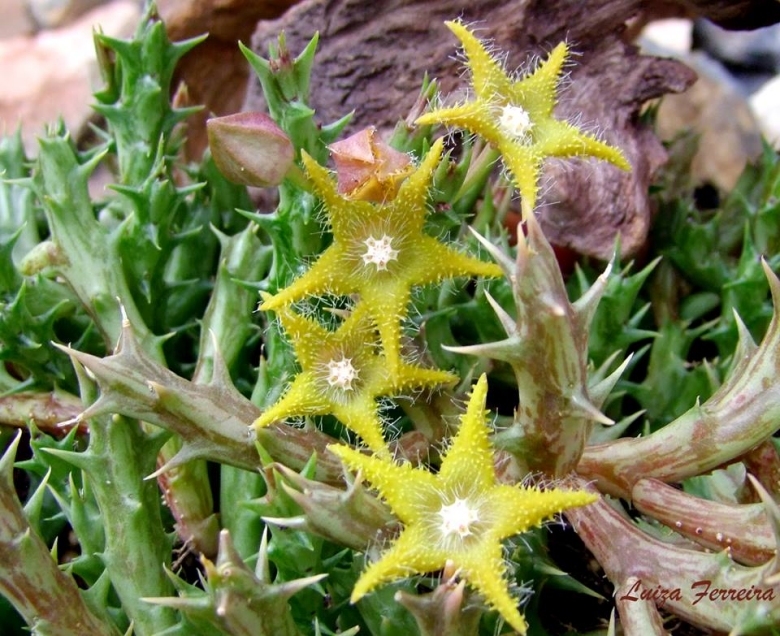
Pachycymbium dummeri (Orbea dummeri) Photo by: Luiza Ferreira
Origin and Habitat: Orbea dummeriSN|30564]]SN|30564]] is native to East Africa (S Kenya, N Tanzania, S Uganda and E. Zaire).
Habitat and ecology: This species grows in arid areas in Acacia-Commiphora bushland and Combretum woodland, where it is occasional on hilltops amongst the outcrop of rocks.
Synonyms:
See all synonyms of Orbea dummeri
back
Accepted name in llifle Database:Orbea dummeri (N.E.Br.) BruynsAloe 37(4): 74 (2000)Synonymy: 5
Accepted name in llifle Database:Orbea dummeri subs. circes (M.G.Gilbert) BruynsAloe 37(4): 74 2000Synonymy: 5
back
Description: Orbea dummeriSN|30572]]SN|30564]] (a.k.a Pachycymbium dummeriSN|30565]]SN|30565]] or Caralluma dummeriSN|30568]]SN|30568]]) is a most unusual perennial soft-wooded succulent of very free flowering habit. The flowers borne on short stalks are starry, greeny-yellow or olive-green in colour and possess a hairy corolla surface. It forms small lax mats to 10 cm tall.
Stems: Erect, spreading or decumbent, 4-angled to rounded 6-9 cm long pale grey-green with purple spots and stripes with conical-subulate slender teeth, 8-15 mm long and 3-5 mm wide horizontally spreading at the base with red stripes.
Flowers: 1 to 6, more or less terminal. Peduncle to 1.5 mm long Bracts c. 2 mm long lanceolate-triangular, pointed. Pedicels 8-12 mm long, c.1.5 mm thick. Sepals 4-5 mm long, 2 mm wide. Corolla 2.5-4 cm across, campanulate, , deeply incised, inside yellow-green, olive-green or dark green; lobes spreading. hairy above. Tube 4-5 mm long, 8-9 mm across, cup-shaped, embracing the corona. Corolla-lobes 13-15 mm long, c 4 mm wide, triangular, long attenuate, horizontally spreading or erect, convex, inside papillate, papillae cylindrical, c.0.5 mm mm long, apically with white 1-1.5 mm long bristly hairs. Corona white or yellowish 3.5-4.5 mm across. Outer corona tubular, lobes 1-1.5 mm long, cup-shaped rectangular when seen from above, apically with 2 lateral teeth, sometimes with additional small tooth-like appendages. Inner corona lobes 1.7-2 mm long, c. 1.3 mm thick, tips irregularly 2- to 3(-5)-toothed, central tooth elongate, apically overlapping. The gynostegium is cylindrical and rather wider towards the base in O. dummeri but conspicuously narrowed towards the base of the outer corona lobes in Orbea circesSN|30564]]SN|30572]]. Pollinia 0.5 x 0.3 mm, ovoid.
Blooming season: Summer.
Fruits: The fruit are paired spindle-shaped capsules (follicles), resembling the horns of an antelope, with the tightly packed seeds inside. At maturity they split open to release numerous small brown seeds crowned with long white hairs.
Bibliography: Major references and further lectures
1) Focke Albers, Ulrich Meve “Illustrated Handbook of Succulent Plants: Asclepiadaceae: Asclepiadaceae” Volume 4 Springer Science & Business Media, 2002
2) Umberto Quattrocchi “CRC World Dictionary of Medicinal and Poisonous Plants: Common Names, Scientific Names, Eponyms, Synonyms, and Etymology” (5 Volume Set) CRC Press, 03 May 2012
3) Schmelzer, G.H. & Gurib-Fakim, A. “Medicinal plants 2” PROTA, 2013
4) Andrew D. Q. Agnew, Shirley Agnew “Upland Kenya wild flowers: a flora of the ferns and herbaceous flowering plants of upland Kenya” East Africa Natural History Society, 1994
5) James Cullen, Sabina G. Knees, H. Suzanne Cubey “The European Garden Flora Flowering Plants: A Manual for the Identification of Plants Cultivated in Europe, Both Out-of-Doors and Under Glass” Cambridge University Press, 11 August 2011
6) A. A. J. Jansen, H. T. Horelli, V. J. Quinn “Food and Nutrition in Kenya: A Historical Review” Department of Community Health, Faculty of Medicine, College of Health Sciences, University of Nairobi, 1987
 Pachycymbium dummeri (Orbea dummeri) Photo by: Luiza Ferreira
Pachycymbium dummeri (Orbea dummeri) Photo by: Luiza Ferreira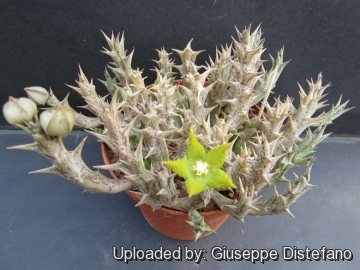 Pachycymbium dummeri (Orbea dummeri) Photo by: Giuseppe Distefano
Pachycymbium dummeri (Orbea dummeri) Photo by: Giuseppe Distefano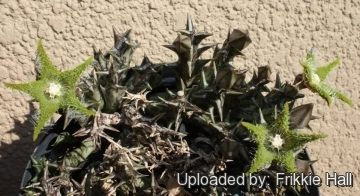 Pachycymbium dummeri (Orbea dummeri) Photo by: Frikkie Hall
Pachycymbium dummeri (Orbea dummeri) Photo by: Frikkie Hall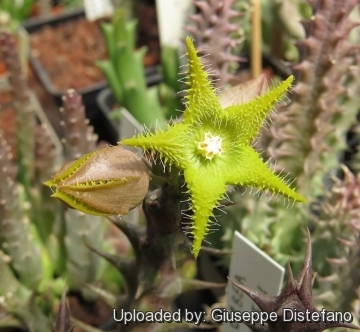 Pachycymbium dummeri (Orbea dummeri) Photo by: Giuseppe Distefano
Pachycymbium dummeri (Orbea dummeri) Photo by: Giuseppe Distefano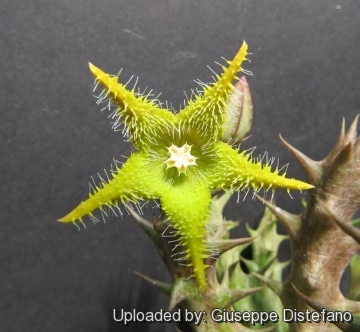 Pachycymbium dummeri (Orbea dummeri) Photo by: Giuseppe Distefano
Pachycymbium dummeri (Orbea dummeri) Photo by: Giuseppe Distefano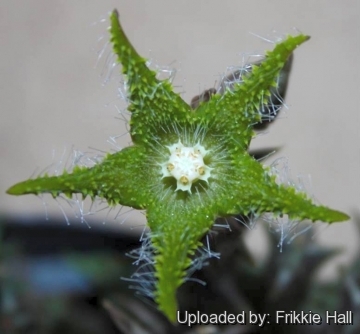 Pachycymbium dummeri (Orbea dummeri) Photo by: Frikkie Hall
Pachycymbium dummeri (Orbea dummeri) Photo by: Frikkie Hall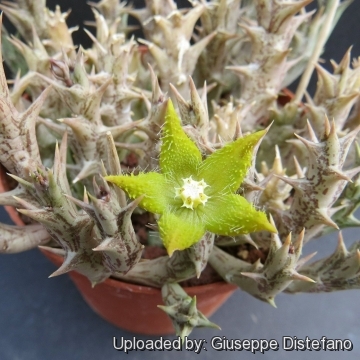 Pachycymbium dummeri (Orbea dummeri) Photo by: Giuseppe Distefano
Pachycymbium dummeri (Orbea dummeri) Photo by: Giuseppe DistefanoSend a photo of this plant.The gallery now contains thousands of pictures, however it is possible to do even more. We are, of course, seeking photos of species not yet shown in the gallery but not only that, we are also looking for better pictures than those already present.
Read More... Cultivation and Propagation: Orbea dummeriSN|30564]]SN|30564]] isn't difficult to grow and flower.
Spring: When winter ends and they begin to grow again, they will require much water and soaking the pots will no longer put the plants at risk for rot. In the spring they will grow well in partial shade and leaving them out in the rain may provide them with the water they need.
Summer: In the summer months they will tolerate heavy rain, but will be just as happy if the season is dry. It's best to sort out the stems while the plants are resting in the summer before they begin their autumnal growth cycle. They will tolerate very hot weather outdoors as long as they are kept in filtered light and this will encourage them to flower in the Autumn. They also enjoy some fertiliser. Moving the plants as they are developing buds may cause them to spontaneously abort the flowers all together.
Autumn: In the fall keep them outdoors until the night time temperatures drop below the 10°C.
Winter: Winter care presents no problems at 10° C with plenty of light. As soon as they are flowered be sure to take extra precautions to keep them dry, because damp cool conditions when the plants are resting is an invitation to fungal infections, but - according to temperatures –some occasional lit watering may be useful.
Potting medium: Since roots are quite shallow, use a cactus mix or add extra perlite or pumice to regular soil potting soil. A gritty, very free-draining compost is suitable, and clay pots help the plants to dry out between watering. Re-pot every 2 years.
Pest and diseases: Orbeas are generally fairly easy to grow, especially if kept pest-free. They are very susceptible to stem and root mealy bugs, and damage from these may well initiate fungal attack. Any time when there is a dead or dying stem in the pot it is important to remove it immediately and completely before other healthy stems can become ill too, isolate the healthy parts, dry them off, and re-root them in new compost.
Medicinal uses: The Turkana people in Kenya drink a decoction of the stems with milk or chew the stems to treat chest pains. Fresh plant sap is squeezed on wounds to heal them. In Uganda the dried and powdered whole plants are put in water and the filtrate is put in the ear to help evacuate ear wax and to treat headache. In Tanzania the latex is applied as ear drops to treat earache.
Food uses: The succulent shoots are chewed by women and children.
Propagation: Easiest with stem cuttings. Allow cuttings to dry a day before planting. Stems must be laid (Not buried) on gritty compost and will then root from the underside of the stems. It can also be increased from seeds sowing in spring in moist, sandy peat moss. Barely cover seeds. Seeds germinate quickly.
In any season it's best to lay the stems out for several days before replanting them and then pot them only in dry soil and withhold any water until they begin to shrivel or start growing again.


















